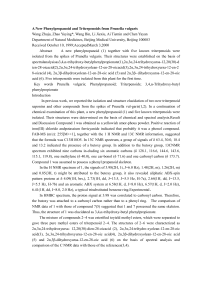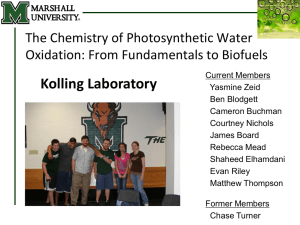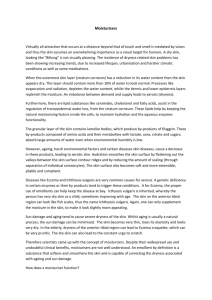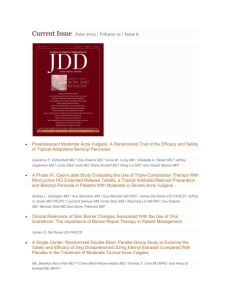Document 13308530
advertisement
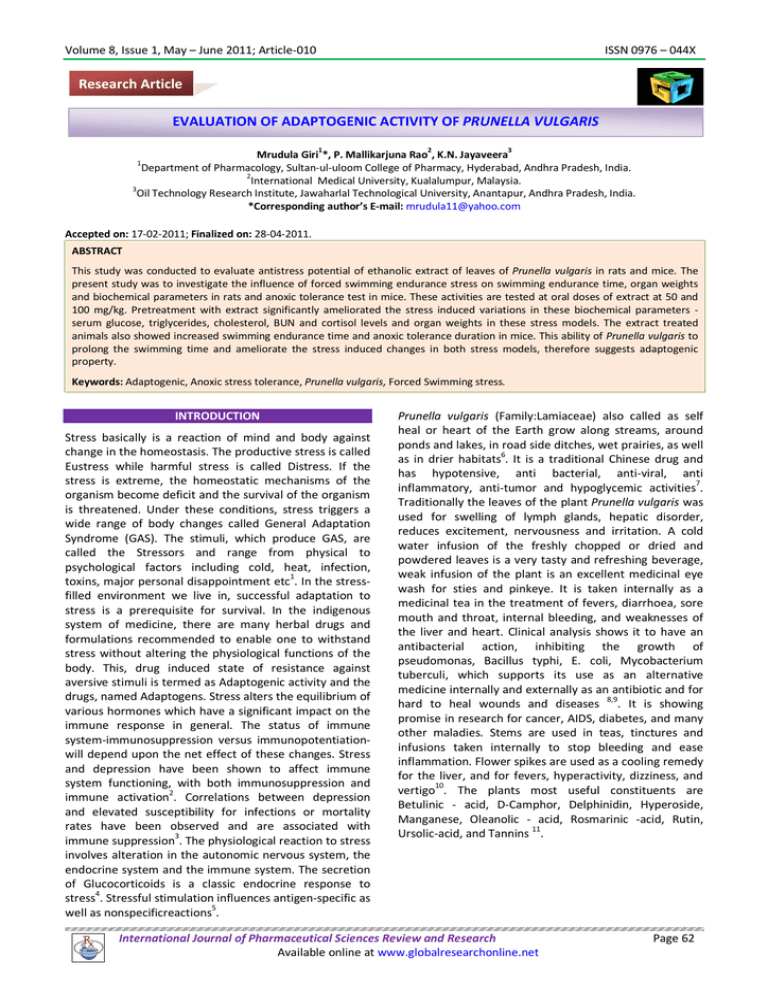
Volume 8, Issue 1, May – June 2011; Article-010 ISSN 0976 – 044X Research Article EVALUATION OF ADAPTOGENIC ACTIVITY OF PRUNELLA VULGARIS 1 2 3 Mrudula Giri *, P. Mallikarjuna Rao , K.N. Jayaveera Department of Pharmacology, Sultan-ul-uloom College of Pharmacy, Hyderabad, Andhra Pradesh, India. 2 International Medical University, Kualalumpur, Malaysia. 3 Oil Technology Research Institute, Jawaharlal Technological University, Anantapur, Andhra Pradesh, India. *Corresponding author’s E-mail: mrudula11@yahoo.com 1 Accepted on: 17-02-2011; Finalized on: 28-04-2011. ABSTRACT This study was conducted to evaluate antistress potential of ethanolic extract of leaves of Prunella vulgaris in rats and mice. The present study was to investigate the influence of forced swimming endurance stress on swimming endurance time, organ weights and biochemical parameters in rats and anoxic tolerance test in mice. These activities are tested at oral doses of extract at 50 and 100 mg/kg. Pretreatment with extract significantly ameliorated the stress induced variations in these biochemical parameters serum glucose, triglycerides, cholesterol, BUN and cortisol levels and organ weights in these stress models. The extract treated animals also showed increased swimming endurance time and anoxic tolerance duration in mice. This ability of Prunella vulgaris to prolong the swimming time and ameliorate the stress induced changes in both stress models, therefore suggests adaptogenic property. Keywords: Adaptogenic, Anoxic stress tolerance, Prunella vulgaris, Forced Swimming stress. INTRODUCTION Stress basically is a reaction of mind and body against change in the homeostasis. The productive stress is called Eustress while harmful stress is called Distress. If the stress is extreme, the homeostatic mechanisms of the organism become deficit and the survival of the organism is threatened. Under these conditions, stress triggers a wide range of body changes called General Adaptation Syndrome (GAS). The stimuli, which produce GAS, are called the Stressors and range from physical to psychological factors including cold, heat, infection, toxins, major personal disappointment etc1. In the stressfilled environment we live in, successful adaptation to stress is a prerequisite for survival. In the indigenous system of medicine, there are many herbal drugs and formulations recommended to enable one to withstand stress without altering the physiological functions of the body. This, drug induced state of resistance against aversive stimuli is termed as Adaptogenic activity and the drugs, named Adaptogens. Stress alters the equilibrium of various hormones which have a significant impact on the immune response in general. The status of immune system-immunosuppression versus immunopotentiationwill depend upon the net effect of these changes. Stress and depression have been shown to affect immune system functioning, with both immunosuppression and immune activation2. Correlations between depression and elevated susceptibility for infections or mortality rates have been observed and are associated with immune suppression3. The physiological reaction to stress involves alteration in the autonomic nervous system, the endocrine system and the immune system. The secretion of Glucocorticoids is a classic endocrine response to stress4. Stressful stimulation influences antigen-specific as well as nonspecificreactions5. Prunella vulgaris (Family:Lamiaceae) also called as self heal or heart of the Earth grow along streams, around ponds and lakes, in road side ditches, wet prairies, as well as in drier habitats6. It is a traditional Chinese drug and has hypotensive, anti bacterial, anti-viral, anti inflammatory, anti-tumor and hypoglycemic activities7. Traditionally the leaves of the plant Prunella vulgaris was used for swelling of lymph glands, hepatic disorder, reduces excitement, nervousness and irritation. A cold water infusion of the freshly chopped or dried and powdered leaves is a very tasty and refreshing beverage, weak infusion of the plant is an excellent medicinal eye wash for sties and pinkeye. It is taken internally as a medicinal tea in the treatment of fevers, diarrhoea, sore mouth and throat, internal bleeding, and weaknesses of the liver and heart. Clinical analysis shows it to have an antibacterial action, inhibiting the growth of pseudomonas, Bacillus typhi, E. coli, Mycobacterium tuberculi, which supports its use as an alternative medicine internally and externally as an antibiotic and for 8,9 hard to heal wounds and diseases . It is showing promise in research for cancer, AIDS, diabetes, and many other maladies. Stems are used in teas, tinctures and infusions taken internally to stop bleeding and ease inflammation. Flower spikes are used as a cooling remedy for the liver, and for fevers, hyperactivity, dizziness, and vertigo10. The plants most useful constituents are Betulinic - acid, D-Camphor, Delphinidin, Hyperoside, Manganese, Oleanolic - acid, Rosmarinic -acid, Rutin, Ursolic-acid, and Tannins 11. International Journal of Pharmaceutical Sciences Review and Research Available online at www.globalresearchonline.net Page 62 Volume 8, Issue 1, May – June 2011; Article-010 MATERIALS AND METHODS Chemicals All the chemicals used were of the analytical grade. Kits for the examination of serum cholesterol, triglycerides, BUN, corticosterone and glucose were purchased from SPAN Diagnostics Kits Ltd. Preparation of extract The leaves of Prunella vulgaris was collected from local area of Hyderabad and authenticated by Dr. Najma, Botanist, S.U.C.P college, Hyderabad. The leaves were shade dried and powdered and extracted with 95 % ethanol for 48 hrs in soxhlet apparatus. The extracts were filtered and concentrated in vacuum under reduced pressure using rotary flash evaporator. A suspension was prepared using distilled water containing 1% (w/v) carboxymethyl cellulose (CMC). Acute Toxicity Studies P.vulgaris ethanolic extract (PV) at different doses (502000 mg/kg) was administered orally to mice and rats with the help of a specially designed oral needle connected to a polythene tube. PV was administered at the same time on each day (i.e. 8 AM- 9 AM). During the first four hours after the drug administration, the animals were observed for gross behavioral changes if any, for 7 days. Parameters such as hyperactivity, grooming, convulsions, hypothermia, sedation and mortality were observed. The doses selected were 50 and 100 mg/kg. ISSN 0976 – 044X was carried out daily for a period of 7 days. At the end of drug treatment, the animals were exposed to the anoxia stress and anoxia tolerance time was noted. Hermetic vessel of one litre air capacity was used to induce anoxia stress. Each animal was kept in the hermetic vessel and the time to show the first sign of convulsion was noted, and were immediately removed from the vessel and resuscitated if needed. Statistical analysis All the values are expresses as mean ± SEM and data was analyzed by one-way ANOVA, using Graphpad INSTAT. The post-hock analysis was carried out by Dunnet’s multiple comparison tests to estimate the significance of difference between individual groups. RESULTS AND DISCUSSION The results of the study revealed that extract posses adaptogenic activity as it significantly (p<0.05) increased swimming time (Fig 1). Forced swimming endurance test (physical stress)12 Rats of either sex (200-250g) were used for forced swim endurance stress. Group I rats received 0.1% CMC in saline; (vehicle control). Group II mice were treated with 0.1% CMC in saline and stress; (negative control). Group III rats were treated with Withania Somnifera (100 mg/kg) and stress; (positive control). Group IV and V rats were treated with ethanolic extract at 50 and100 mg/kg, p.o. and stress. The rats were subjected to swimming stress by keeping them in propylene tank of dimension (37Χ37Χ30 cm), filled with water to a height of 25cm. Extracts were given to rats, once daily for period of 7 days. On 8th day the rats were allowed to swim till complete exhaustion and the endpoint was taken when the animal started drowning. The mean swimming time for each group was calculated. Then animals were killed and blood was collected by cardiac puncture to estimate biochemical parameters like serum glucose, triglycerides, cholesterol, BUN and cortisols. The weights of organs such as liver, adrenals, spleen were recorded after washing with alcohol. Anoxic stress tolerance test in mice13 Mice of either sex were divided randomly into 5 groups, each group containing 6 mice. Group I mice received 0.1% CMC in saline; (vehicle control). Group II mice were treated with Withania somnifera (100 mg/kg, p.o.); Group III and IV rats were treated with ethanolic extract at doses of 50 and 100 mg/kg, p.o. and stress. The drug treatment Figure 1: Effect of ethanolic extract of Prunella vulgaris in forced swimming endurance test in rats (Swimming time). The mean increase in duration of swimming time was noted. *p<0.05 significant as compared to control. **p<0.05 significant as compared to stress control. Statistical test employed is Anova followed by dunnets test. Swimming endurance stress resulted in significant increase in adrenal weight with concomitant increase in spleen weight in stress control group, which was significantly (p<0.05) reverted by Prunella vulgaris pretreatment at 50 and 100 mg/kg (Table 1). Pretreatment of animals with above two doses (p<0.05) also significantly restored back forced swimming alterations in plasma cortisol, triglycereides, glucose, BUN, Cholesterol (Table 2). The extract at different doses offered significant protection against anoxia induces stress changes in rats. The Anoxia tolerance test was determined by taking the appearance of convulsion as end point. The Prunella vulgaris at a Dose I (50 mg/kg/ b.w) and Dose II (100 mg/kg/ b.w) showed significant (p<0. 001) increasing tolerance stress time in 7th day as compared with the control (Fig 2, Table 3). Adaptogens are the substances meant to put the organs into a state of non-specific heightened resistance in order to resist stressor better and adapt to extraordinary International Journal of Pharmaceutical Sciences Review and Research Available online at www.globalresearchonline.net Page 63 Volume 8, Issue 1, May – June 2011; Article-010 ISSN 0976 – 044X challengers. They normalize body functions, strengthen systems and functions that are compromised by stress and have a protective effect against a wide variety of environmental and emotional stress. The forced swimming is the most widely used method for assessing the anti-stress property of a novel compound. This paradigm is based on the observation that animals when forced to swim in water eventually assumed a characteristic immobile posture, devoid of any activity. The appearance of immobility therefore, reflects a state of tiredness, fatigue, reduced stamina with the end point being the moment when the mice could not swim further and started drowning. The increased swimming time has been observed in mice, pre-treated with Prunella vulgaris with enhanced physical performance significantly longer than untreated (control) group and thus confirming its adaptogenic nature. In response to stress, ACTH is released, which acts on the adrenal cortex to stimulate the synthesis and release of cortisol14. Table 1: Effect of ethanolic extract of Prunella vulgaris on organ weight in forced swimming endurance stress in rats Treatment Control Swimming stress (control) Withania somnifera (100 mg/kg p.o) P.Vulgaris extract (50 mg/kg p.o) P.Vulgaris extract (100 mg/kg p.o) Spleen (mg/100g) 269.45± 1.52 194.68±1.84 280.75±0.89* 210.68 ±1.19 258.25±0.76* Organs Weight Liver (g/100 g) Adrenal glands (mg/100 g) 3.48±1.72 16.89±0.55 5.54±0.98 38.26±1.78 3.65±1.56* 14.55±0.96* 4.80±0.57 32.54±2.54 4.05±0.85* 20.98±0.76* The values are expressed as Mean±SEM, n = 6 in each group. Significance at *p<0.05 when compared to stress control as determined by ANOVA followed by Dunnet’s t test Table 2: Effect of ethanolic extract of Prunella vulgaris on biochemical parameters in forced swimming endurance stress in rats Groups Cortisol (µg /dL) Glucose (mg/dL) Cholestreol (mg/dL) Triglycerides (mg/dL) BUN (mg/mL) Control 88.75±2.64 100.2±2.54 90.14±1.11 136.5±2.78 40.18±2.58 Swimming stress (control) Withania somnifera(100 mg/kg p.o) P.Vulgaris extract (50 mg/kg p.o) P.Vulgaris extract (100 mg/kg p.o) 149.56±4.89 93.78±0.76** 128.38± 1.65 110.26 ±1.79** 165.45±3.14 110.38±3.58** 140.55±2.69* 122.74±1.85** 179.48±1.56 87.6±1.98** 125.4±2.62 108.3±1.25** 198.4±3.56 123.6±1.81** 165.8±5.24* 130.4±1.68** 54.25±3.56 35.14±1.10** 44.08±1.59 39.84±2.52* The values are expressed as Mean±SEM, n = 6 in each group. Significance at *p<0.05 when compared to control Significance at **p<0.05 when compared to stress contro, l Statistical test employed is ANOVA followed by Dunnet’s t test Table 3: Effect of ethanolic extract of Prunella vulgaris on Anoxic tolerance test in mice Groups Control Withania somnifera (100mg/kg p.o) P.Vulgaris extract (50 mg/kg p.o) P.Vulgaris extract (100 mg/kg p.o) Duration of anoxic Stress tolerance (min) 22.48±4.12 68.92±1.76* 37.54±0.89 51.36±1.567* All values expressed, mean ± SEM, test group vs. Anoxic stress tolerance group *p<0.05,by One way ANOVA. Figure 2: Effect of ethanolic extract of Prunella vulgaris in Anoxic tolerance test .The mean increase in duration of anoxic stress tolerance was noted. *p<0.05 significant as compared to control. Statistical test employed is Anova. Increased plasma cortisol influences the mobilization of stored fat and carbohydrate reserve 15 which inturn increases blood glucose level. The increased cortisols levels are reversed by antistress agents15. Prunella vulgaris significantly decreased the stress induced elevated levels of cortisol and blood glucose levels. The reference drug in this study, Withania Somnifera, also produced similar results. The marked increase in serum cholesterol, triglycerides and BUN levels in stress induced animals is due to stimulation of Hypothalamic-pituitary axis (HPA) and sympathetic system resulting in liberation catecholamines and glucocotticoids, which inhibit the 16 immune system at multiple sites like liver, kidney . Prunella vulgaris as well as standard drug Withania somnifera significantly (p<0.05) reduced the serum cholesterol, BUN and triglycerides which may be due to inhibition of stimulation of sympathetic nervous system. The increase in weight of adrenals in stressed animals is due to the stress induced adrenomedullary response leading to increased production of corticotrophic hormone that leads to increase in weight of adrenals17. Prunella vulgaris and Withania somnifera significantly (p<0.05)reduced the liver, adrenal gland weight, this may due to reversal of stress induced adrenomedullary International Journal of Pharmaceutical Sciences Review and Research Available online at www.globalresearchonline.net Page 64 Volume 8, Issue 1, May – June 2011; Article-010 ISSN 0976 – 044X response and hence decreased production of corticotropic hormone. The decrease in weight of spleen may be due to recruitment of lymphocytes to blood from 18 spleen, which results from squeezing of spleen . Pretreatment with Prunella vulgaris and reference standard Withania somnifera significantly (p<0.05) increased the spleen weight. This may be due to inhibition of recruitment of lymphocytes to blood from spleen. Anoxia is a very severe stressor. All the body functions including cellular respiration depend on oxygen supply to them. Any lack of this vital element plays havoc on all body mechanism. Increase in adaptation during this stress by any drug could be considered as its major antistress effect. The results of the study shown that the Prunella vulgaris significantly prolonged the meantime to convulsion, which therefore confirm its antistress property. Prolongation of meantime to convulsion could be as a result of its powerful antioxidant and free redical scavenging activities. A variety of biological activities including adaptogenic activity were reported with flavanoids, tannins and Phenolic glycosides18. Prunella vulgaris contains biologically active chemicals that include flavanoids, tannins, phenolic glycosides and triterpenes11. The adaptogenic activity may be due to these constituents, whereas standard drug Withania somnifera An established adaptogenic drug too contains glycosides, steroids and flavanoids18. 5. Ader R and Cohen N I. Psychoneuroimmunolgy: Conditioning and stress. Annu. Rev. Psychol. 44 : 1993, 53-85 . 6. Fang X,Yu MM, Yuen WH, Zee SY, Chang RC. Immune modulatory effects of Prunella Vulgaris L. on monocytes/macrophages. Int J Mol Med. 16(6): 2005, 1109-16. 7. Nolkemper S, Reichling J, Stintzing FC, Carle R, Schnitzler P. Antiviral effect of aqueous extracts from species of Lamiaceae family against Herpes simplex virus type 1 type 2 in vitro. Plant med. 72(15): 2006, 1378-82. 8. Chiu LC, Zhu W,Oci V. A polysaccharide fraction from medicinal herb Prunella vulgaris down regulates the expression of herpes simplex virus antigen in Vero cells. J Ethno Pharmacol.93 (1): 2004, 63-8. 9. Skottova N, Kazdova L, Oliyarnyk O, Vecera R, Sobolova L, Ulrichova J. Phenolics-rich extracts from Silybum marianum and Prunella vulgaris reduce a high-sucrose diet induced oxidative stress in hereditary hyper triglyceridemic rats. Pharmacol Res.50(2): 2004, 123-30. 10. Psotova J, Kolar M,Sousek J, Svagera Z,Vicar J, Ulrichova J. Biological activities of Prunella vulgaris extract. Phytother Res.17(9): 2003, 1082-7. 11. Shin T, Kim YK, Kim HM (2001). Inhibition of immediatetype allergic reactions by Prunella vulgaris in a murine model. Immuno pharmacol Immunotoxicol.23(3):423-9. 12. Bhargava KP and Singh N. Antistress activity of Ocimum sanctum Linn. Indian J MedRes.73:1981,443-451. 13. Tomar VS, Singh SP and Kohli RP. Effect of geriforte A herbal compound drug on anoxic tolerance in animals, Indian Drugs.3:1984, 233-235. 14. Sadock BJ and VA Sadock. Major depression and bipolar th disorder kalpan and sadocks synopsis of psychiatry. 9 edition., Lippincott Williams and Wilkins Philadelphia, 2003, pp: 534-590. 15. Tache Y and Seyl. Shift in adenohypophyseal activity during chronic intermittent immobilization of rats. Neuronendocrinology. 22: 1976, 325-336. 16. Sen P,P Maiti, S Puri and A Ray. Mechanism of antistress activity of Ocimum sanctum(Linn), eugenol and Tinospora malabaria in experimental animals. Indian J.Exp. Biol.30:1992, 592-596. CONCLUSION In conclusion, present results suggest that administration of Prunella vulgaris is capable of increasing the capacity to tolerate non specific stress in experimental animals as evident from the restoration, of a large number of parameters studied during different types of stress and acts as an adaptogenic agent. REFERENCES 1. Selye H. The evolution of the stress concept. American Scientist. 61, 1973, 693-699. 2. Raison CL and Miller AH. The neuroimmunolgy of stress and depression. Semin. Clin. Neuropsychiatry. 6, 2001, 277-294 . 3. Irwin M, Psychoneuroimmunology of depression: Clinical implication. Brain Behav. Immunol. 16, 2002, 1-16. 17. 4. Sapolsky RM, Romero LM. and Munck AU. How do glucocorticoids influence stress response? Integrating permissive, suppressive, stimulatory and preparative actions. Endocrinol. Rev. 21 : 2000, 55-89 . Schimmer BP and KL Parker. Adrenocortical steroids and th their synthetic analogues. 11 Edn., McGraw-Hill Medical Publishing, NewYork, 2006, PP: 1655-1662. 18. Krupavarm B, N Venkat Rao, Nanda Kumar, TS Gowda, MD Shalam and S.Shantakumar. Study on adaptogenic activity of root extracts of Boerhaavia diffusa (Linn). Indian drugs. 44: 2007, 264-270. **************** International Journal of Pharmaceutical Sciences Review and Research Available online at www.globalresearchonline.net Page 65
